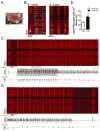Imaging atrial arrhythmic intracellular calcium in intact heart
- PMID: 24041536
- PMCID: PMC4387875
- DOI: 10.1016/j.yjmcc.2013.09.003
Imaging atrial arrhythmic intracellular calcium in intact heart
Abstract
Abnormalities in intracellular Ca(2+) signaling have been proposed to play an essential role in the pathophysiology of atrial arrhythmias. However, a direct observation of intracellular Ca(2+) in atrial myocytes during atrial arrhythmias is lacking. Here, we have developed an ex vivo model of simultaneous Ca(2+) imaging and electrocardiographic recording in cardiac atria. Using this system we were able to record atrial arrhythmic intracellular Ca(2+) activities. Our results indicate that atrial arrhythmias can be tightly linked to intracellular Ca(2+) waves and Ca(2+) alternans. Moreover, we applied this strategy to analyze Ca(2+) signals in the hearts of WT and knock-in mice harboring a 'leaky' type 2 ryanodine receptor (RyR2-R2474S). We showed that sarcoplasmic reticulum (SR) Ca(2+) leak increases the susceptibility to Ca(2+) alternans and Ca(2+) waves increasing the incidence of atrial arrhythmias. Reduction of SR Ca(2+) leak via RyR2 by acute treatment with S107 reduced both Ca(2+) alternans and Ca(2+) waves, and prevented atrial arrhythmias.
Keywords: Atrial arrhythmias; Ex vivo model; Intracellular Ca(2+) imaging.
© 2013.
Figures


References
-
- Go AS, Hylek EM, Phillips KA, Chang Y, Henault LE, Selby JV, et al. Prevalence of diagnosed atrial fibrillation in adults: national implications for rhythm management and stroke prevention: the AnTicoagulation and Risk Factors in Atrial Fibrillation (ATRIA) Study. JAMA. 2001;285:2370–5. - PubMed
-
- Lin YJ, Higa S, Tai CT, Chang SL, Lee KT, Lo LW, et al. Role of the right atrial substrate in different types of atrial arrhythmias. Heart Rhythm. 2009;6:592–8. - PubMed
-
- Santulli G, D’Ascia C. Atrial remodelling in echocardiographic super-responders to cardiac resynchronization therapy. Heart. 2012;98:517. - PubMed
-
- Yu WC, Chen SA, Lee SH, Tai CT, Feng AN, Kuo BI, et al. Tachycardia-induced change of atrial refractory period in humans: rate dependency and effects of antiarrhythmic drugs. Circulation. 1998;97:2331–7. - PubMed
Publication types
MeSH terms
Substances
Grants and funding
LinkOut - more resources
Full Text Sources
Other Literature Sources
Medical
Research Materials
Miscellaneous

